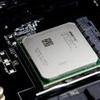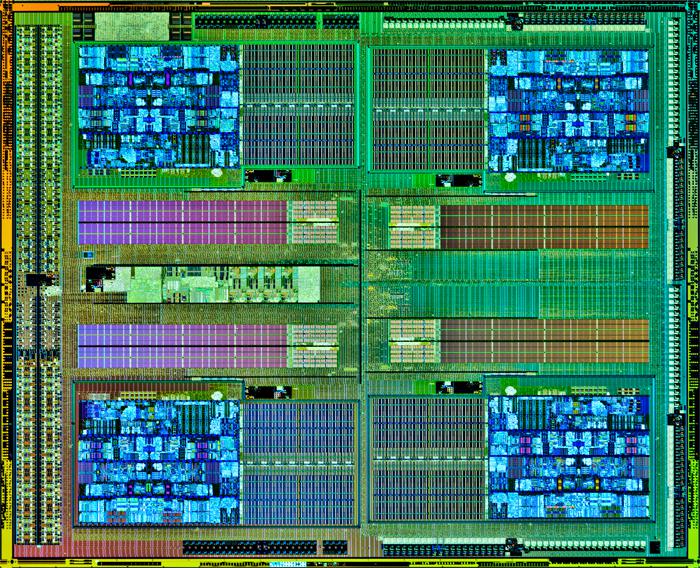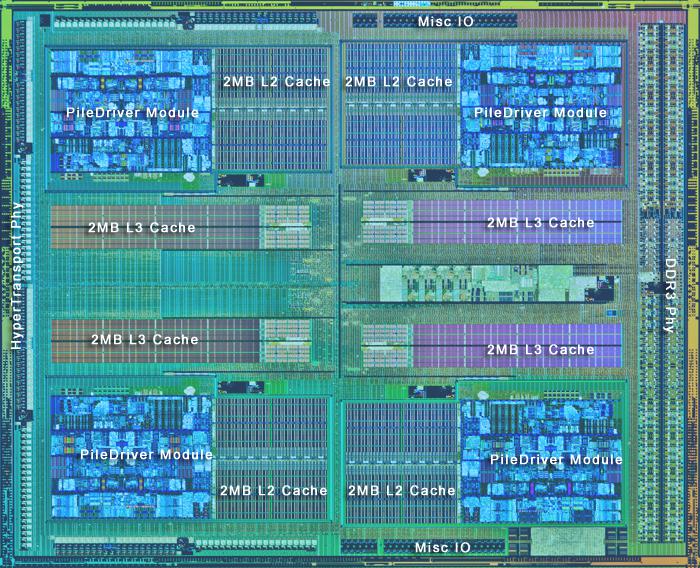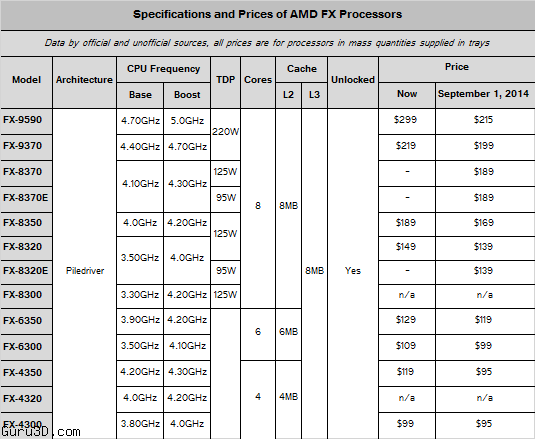The Architecture - Cache - Compilers - processors
The Architecture
The 2nd generation FX series processors have been built upon what you guys know as the Vishera architecture, all managed on the very same 32nm fabrication node. Each Vishera processor will have Piledriver units, or segmented modules. This is very simple, one Piledriver module basically has two logical AMD64 CPU cores tied together. With four Piledriver modules you thus get eight logical CPU cores. Please have a look at the die photo below where you will understand it more easily after observing.
The roughly 1.2 Billion transistor count FX-8350 processor tested today thus has four Piledriver modules, each of which contains two AMD64 cores, and an integrated memory controller. Take a look at the die shot below where I filled out the most important segments:
Vishera processor die with labels
Different though in this new design is that each module shares several components including a front-end (fetch and decode), floating-point unit, data prefetch unit, and 2MB of L2 cache. The shared Piledriver modules made it possible to group more cores on a smaller die and boost the horsepower of the floating-point unit, so that is all about gaining as much efficiency as possible. You can understand it's also very modular. AMD could make 2,4,6,8,10,12,14,16 and so on core processors when the time is right and the technology allows it. It is a very scalable base design. The eight-core PileDriver based FX processor is manufactured by GlobalFoundries on its 32nm SOI (Silicon-On-Insulator) process. Like the A-Series APUs for mainstream laptops, it measures 315 square millimeters and has roughly 1.2 Billion transistors. The processor has an AM3+ package and thus it can be seated on the series 900 AMD chipset based motherboards.
Piledriver CPU Cores
We do need to get a littler deeper into the processors cores as thee have been significant changes. The 2nd generation Bulldozer cores are Piledriver, as such Piledriver cores are used inside the new Trinity APUs and not the FX series as well. AMD claims that they have tweaked the logical CPU cores a little to make them perform the way they are intended to be. Inside the processor you'll spot the clusters as explained. Per module we see two integer CPU-cores which both share a floating point unit. Each module has a 2MB L2 cache and the L3 cache. The processor cores have been tweaked, the average instruction per clock-cycle has improved by a another say 10% One more improvement for Vishera was AMD Turbo Core 3.0, the technology has been enhanced. The Turbo mode can clock the processor cores up and down real fast when the power usage and temperature allow for it. The CPU tested today can turbo towards 4200 MHz.
The Caches
Caches then, there are no significant changes opposed to the last gen Bulldozer FX processor, however opposed to say Phenom II and Athlon II there are big differences alright. Here again it's all quite simply. Each separate CPU core has 128 KB of Level 1 Cache, 16 KB/Core x8 Data cache 64-byte cacheline, 4-way associative, write-through. Then a L1 Instruction cache of 64KB is availalable, 2-way associative with a 64-byte cacheline x4. For the eigh-core SKUs there is 8 MB of Level 2 Cache in total, 2 MB per module and this 1MB per core next to a 64-byte cacheline, 16-way associative. There is a third cache. AMD has designed a shared 8 MB L3 cache with 64 way associatively for both cores in a Piledriver module. Each Piledriver unit (per two cores) will have 2 MB L3 cache. Each module can access the entirety of the 8MB L3, although cache partitioning happens on a core & thread generation basis so its virtually impossible for one core to get allocated the full 8MB of L3. The one exception is that the four core FX-4300 processor will have a 4MB L3 cacche assigned to it. The FX 8370/8350/8320 and 6300 will all have access to that large 8MB L3 cache.
New Instruction sets (compilers)
Bulldozer already had several new instructions including some that are in both AMD and Intel processors (SSE, encryption, and AVX for floating-point operations) and some unique to AMD that fill in some holes including FMA4 for HPC applications and XOP for numeric, multimedia, and audio/radio applications. Good news is to see support for AVX, AVX 1.1, FMA3 and AES instructions sets supported as well.
The Processor SKUs
For the 2nd generation of FX series processors will see three new processors being launched today. The FX 8320E, the 8370E and the 8370.




